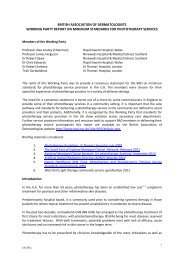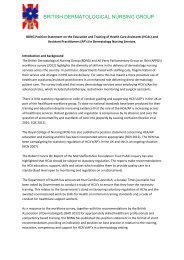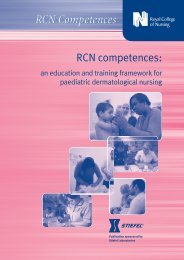Improving outcomes for people with skin tumours including melanoma
Improving outcomes for people with skin tumours including melanoma
Improving outcomes for people with skin tumours including melanoma
Create successful ePaper yourself
Turn your PDF publications into a flip-book with our unique Google optimized e-Paper software.
<strong>Improving</strong> Outcomes <strong>for</strong><br />
People <strong>with</strong> Skin Tumours<br />
<strong>including</strong> Melanoma<br />
Management of special<br />
groups<br />
Skin lymphomas<br />
Skin lymphomas represent a special group because of their rarity and<br />
complexity in diagnosis and because of service overlap <strong>with</strong><br />
haematology. There are two key national clinical guidelines <strong>for</strong><br />
cutaneous lymphoma: the Royal College of Pathologists minimum<br />
dataset <strong>for</strong> lymphoma 56 and the joint BAD/UK Skin Lymphoma Group<br />
Guidelines <strong>for</strong> the management of primary cutaneous T-cell lymphoma<br />
(CTCL). 57 The NICE guidance <strong>Improving</strong> <strong>outcomes</strong> in haematological<br />
cancer 58 is also relevant, though not specifically concerned <strong>with</strong><br />
primary cutaneous lymphoma.<br />
There are approximately 300 new cases of cutaneous lymphoma<br />
annually in the UK. Although all cutaneous lymphomas are malignant,<br />
the majority are of low-grade biological type and associated <strong>with</strong> long<br />
survival, so accordingly the prevalence is relatively high. Unlike other<br />
lymphoma patients, most individuals <strong>with</strong> <strong>skin</strong> lymphomas require<br />
directed treatment of their <strong>skin</strong> and not systemic chemotherapy,<br />
which is only needed <strong>for</strong> patients <strong>with</strong> advanced disease. The<br />
histological diagnosis of <strong>skin</strong> lymphoma is a specialised field and has<br />
been included in the National Pathology and Dermatology Specialised<br />
Services.<br />
6<br />
A primary cutaneous lymphoma is defined as a lymphoma arising<br />
<strong>with</strong>in the <strong>skin</strong> <strong>with</strong>out evidence of systematic spread at presentation.<br />
Approximately 30% of cases are B-cell and the remainder are T-cell<br />
(CTCL), <strong>with</strong> a few NK-cell lymphomas. The commonest type of<br />
cutaneous T-cell lymphoma is mycosis fungoides, which accounts <strong>for</strong><br />
approximately 70% of all cases of CTCL. Prognosis in CTCL varies<br />
widely depending on subset and stage: patients <strong>with</strong> lymphomatoid<br />
papulosis or stage 1a mycosis fungoides have a virtually normal life<br />
expectancy whereas patients <strong>with</strong> CD30-negative large cell lymphoma,<br />
or Sézary syndrome, have a median survival of less than 5 years.<br />
Clinical and pathological expertise is there<strong>for</strong>e crucial <strong>for</strong> making the<br />
correct diagnosis and thus deciding the appropriate therapy. In<br />
addition, molecular analysis of tumour tissue also provides valuable<br />
diagnostic in<strong>for</strong>mation, and molecular analysis of blood and lymph<br />
tissue can provide valuable prognostic in<strong>for</strong>mation in patients <strong>with</strong><br />
mycosis fungoides. Similar principles apply to other types of<br />
cutaneous lymphoma. Whereas patients <strong>with</strong> marginal zone B-cell<br />
lymphoma have a 5-year survival of almost 100%, those <strong>with</strong> blastic<br />
NK-cell lymphoma have a 5-year survival of less than 20%. Thus all<br />
56 Royal College of Pathologists. Standards and minimum datasets <strong>for</strong> reporting cancers.<br />
Available from: www.rcpath.org<br />
57 British Association of Dermatologists (2003) Guidelines <strong>for</strong> the management of primary<br />
cutaneous T-cell lymphomas. Available from: www.bad.org.uk/healthcare/guidelines<br />
58 National Institute <strong>for</strong> Clinical Excellence (2003) <strong>Improving</strong> <strong>outcomes</strong> in haematological<br />
cancer. Available from: www.nice.org.uk<br />
114<br />
National Institute <strong>for</strong> Health and Clinical Excellence















